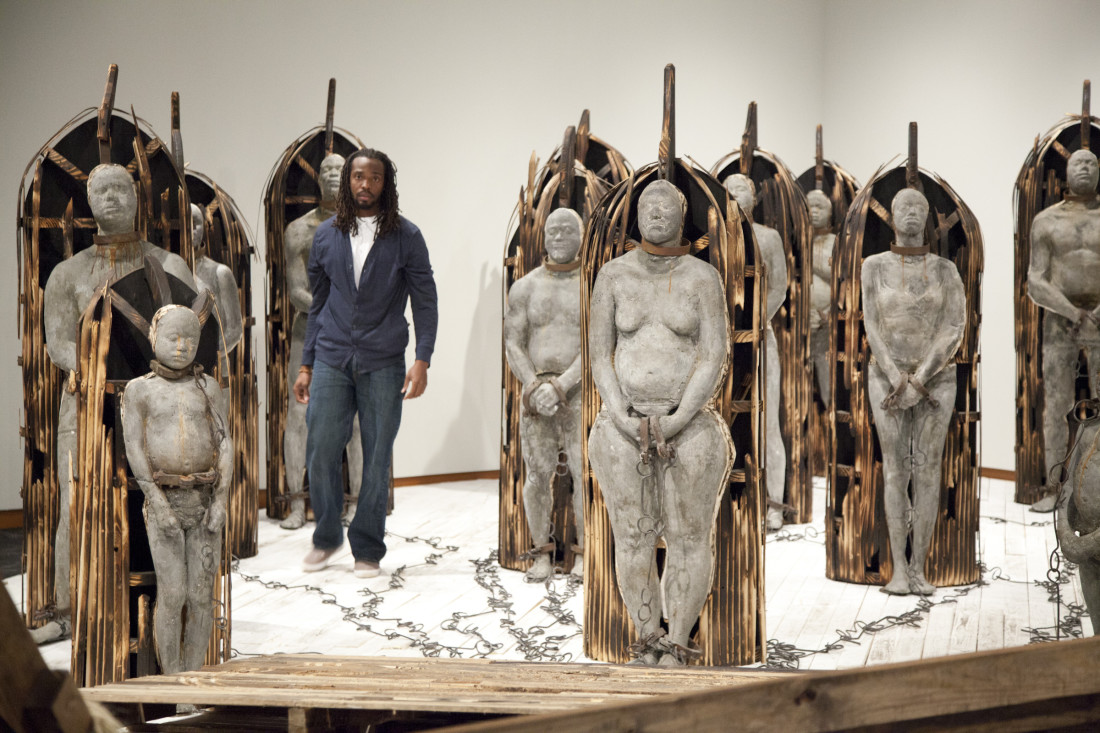Between 1502 and the mid-1860s, more than 15 million people were placed in chains and loaded onto boats that sailed from West African shores to Brazilian ports, Caribbean sugar plantations and American cities like Wilmington, N.C., Mobile, Ala. and Charleston, S.C. There, the 12 million or so who survived the monthslong Middle Passage, shackled and stacked in the pestilent hulls of slave ships, were immediately sold into a lifetime of physical labor.
Chilling though such facts may be, they don’t provide the visceral punch brought on by actually seeing the physical vestiges of the trans-Atlantic slave trade: deeds for individual human beings, auction blocks, slave cabins and antebellum plantation homes, whether wholly preserved or burned-out shells. And lest we forget, the tick-marked stowage charts that slave traders used to map out and efficiently load their “cargo.”
Cash Crop, an exhibit by Durham-based artist Stephen Hayes that’s now on view in the YMI Cultural Center’s Ray Auditorium, is both a meditation on and a visual representation of this ugly chapter of our shared American history. Like the raw materials themselves, such artworks help personalize these tragic practices, evoking deeper understanding and perhaps reaching otherwise untouched audiences.
The show features 15 life-size figurative sculptures, cast in concrete and bound at the feet, wrists and necks with metal shackles. Each figure represents 1 million of those human lives uprooted from their homes and forced into slavery. The men’s and women’s chalky gray bodies stand defiantly, their blank, steely gazes hauntingly frozen. The children, meanwhile, shoulders dipping in youthful innocence as rust-colored tears run down their cheeks, serve as grim reminders that they, too, were bought and sold.
Each figure stands in front of a scale-model slave ship to which its neck is bound by a single metal loop. The ships stand upright, balanced on their sterns; the bows arch above the figures’ heads, forming a shieldlike human-sized vessel behind each one. On the back of each ship, Hayes has replicated cargo diagrams showing hundreds of small black figures crammed in like sardines. Chains connected to the wrist and ankle shackles snake through the gallery, linking each of the 15 figures to one another but also to a central object at the head of the gallery: a wooden pallet.
Much like the chains, the pallet serves to link past and present. While the American slave trade has long been outlawed, some of the same financial systems, trade markets and symbology that existed then — not to mention the consumer populations — have only expanded in subsequent centuries. Hayes has carved one of those symbols, taken from the Great Seal of the United States, into the wood. The shield-bearing, olive-branch-and-arrow-wielding bald eagle holds a banner in its beak that, as in the original, displays the phrase “E Pluribus Unum.”
Hayes likens the trans-Atlantic slave trade to the child and slave labor now used to produce and transport everything from clothing and electronics to precious metals and shrimp. Part history lesson, part socio-political commentary, Cash Crop challenges viewers to take a deeper look at contemporary culture. In a sense, notes the artist, the underlying economic structure remains the same: Only the goods have changed. “We used to ship people to America; now we ship goods,” he says. “Instead of people, it’s pallets.”
Cash Crop is on view through Wednesday, Aug. 27, in the YMI Cultural Center’s Ray Auditorium, Tuesday through Friday from noon to 4 p.m. The exhibit is free and open to the public. For more information, visit ymiculturalcenter.org




Before you comment
The comments section is here to provide a platform for civil dialogue on the issues we face together as a local community. Xpress is committed to offering this platform for all voices, but when the tone of the discussion gets nasty or strays off topic, we believe many people choose not to participate. Xpress editors are determined to moderate comments to ensure a constructive interchange is maintained. All comments judged not to be in keeping with the spirit of civil discourse will be removed and repeat violators will be banned. See here for our terms of service. Thank you for being part of this effort to promote respectful discussion.